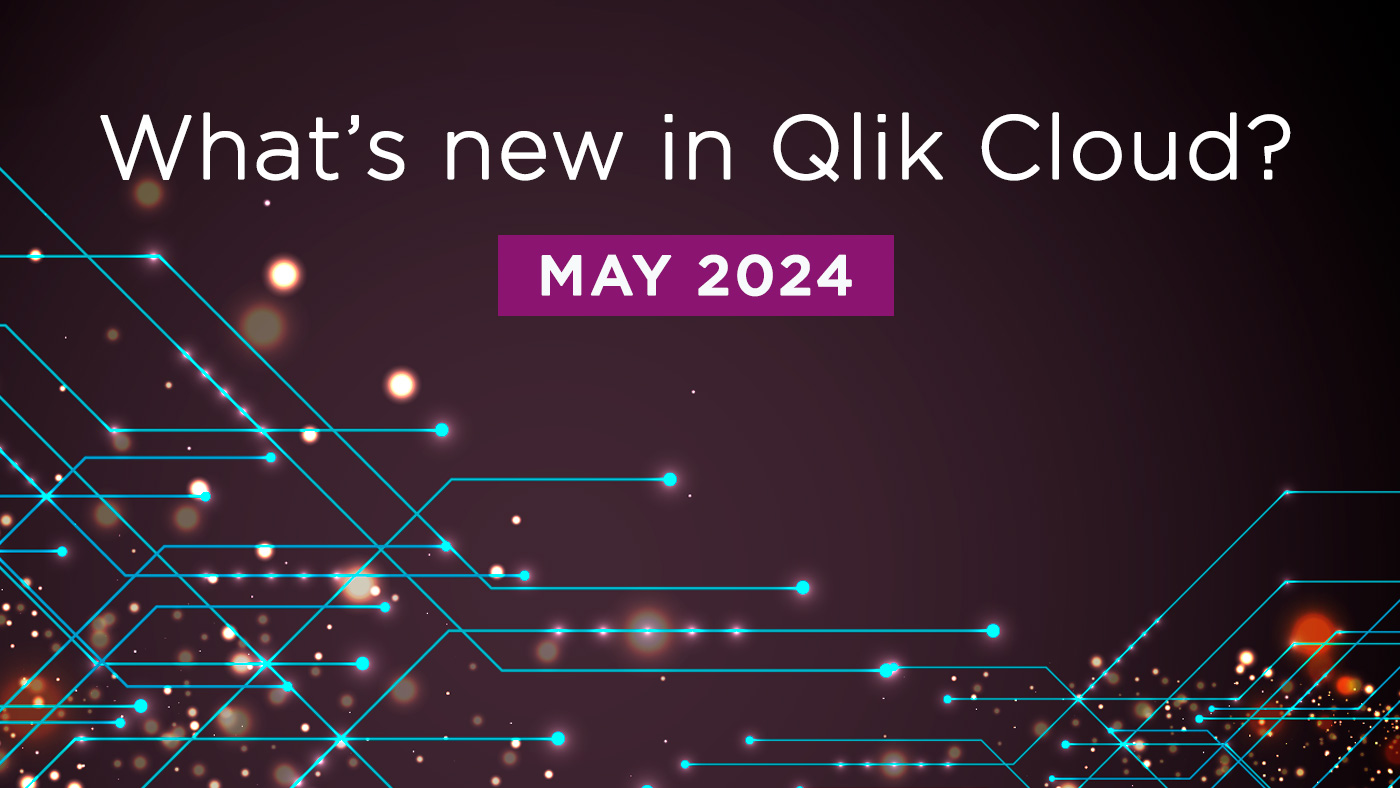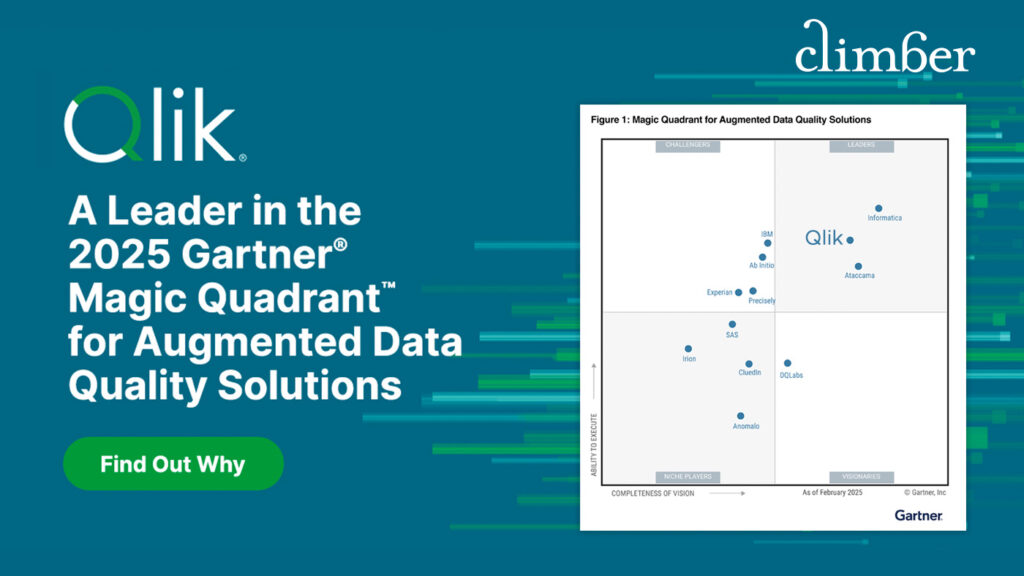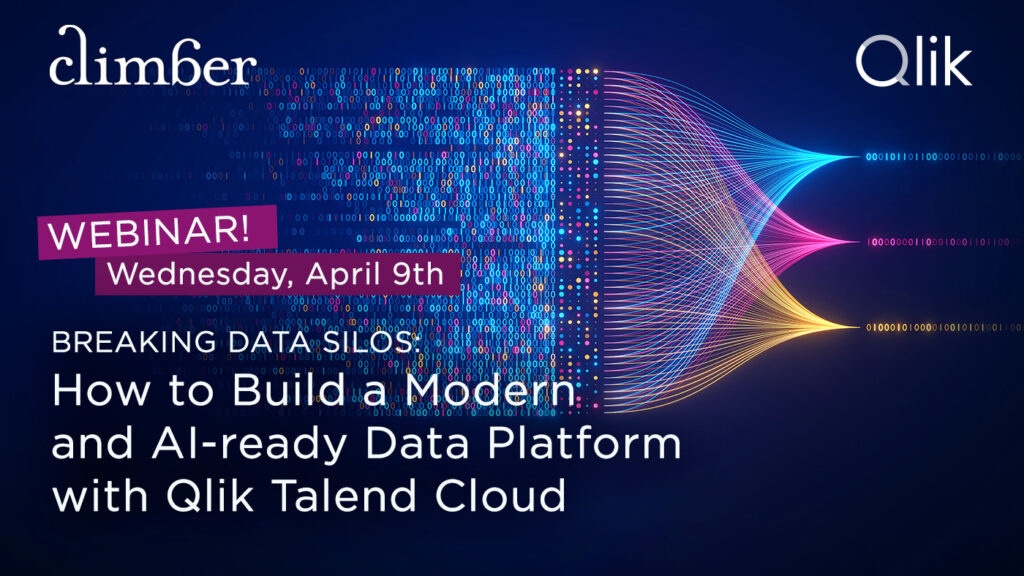
What’s New in Qlik Cloud
– May 2024 Updates –
Welcome to the next edition of the ‘What’s New in Qlik Cloud’ blog for May 2024. This month you will find out about new releases in Qlik Cloud Data Integration, focusing on enhancements to data transformation with the data transformation flow being added to the Transform component of a QCDI project. In the Analytics space there are enhancements to the Amazon connectors and the administrative / development functionality.
Authors: Roger Gray, BI Manager, & Mark James, Data Integration Consultant, at Climber.
Data Analytics
This month’s updates include enhancements to the Amazon connectors, usability and support of Qlik Cloud functionality, and more details around writing inline load statements. This will be a great aid to any novice Qlik script developers.
1. New Amazon DynamoDB Connector, ODBC-based
Qlik is introducing the new Qlik DynamoDB connector, providing effortless access to NoSQL data stored in an AWS DynamoDB database service. This connector offers streamlined configuration options directly in the connection definition interface and supports authentication using AWS IAM credentials or a credentials file. Say goodbye to complexity through the previous JDBC-based connector and do migrate before the end of support date of July 2024!
2. Added Support for Amazon Bedrock Claude 3
Qlik Cloud now supports Claude 3 Sonnet and Haiku in the Anthropic (Amazon Bedrock) analytic connector. Harness the power of Amazon Bedrock analytics and gain deeper insights into your data landscape.
3. Improved Usability and Support of QVS Script Files
Qlik Cloud now supports the seamless integration of QVS files into load scripts, ushering in a new era of scripting best practices. With enhanced support for QVS files, users can leverage reusable content such as subroutines, variables, and colour palettes across multiple apps and scripts. The new QVS viewer allows for easy access and viewing of file content, promoting script reuse and modularity.
4. Runtime Evaluation Option for Actions
Experience newfound flexibility with the runtime evaluation option for actions. This feature enables expressions to be evaluated dynamically during runtime, allowing for values set in one action to be passed on to subsequent actions in the chain. Empower your analytics with real-time responsiveness and agility!
5. App Performance Evaluator Enhancements
Qlik has introduced a significant enhancement to the performance evaluator in Qlik Cloud. Now, users receive detailed reports on sub-parts of objects that encounter issues or cannot be evaluated. From calculation conditions to disabled expressions, stay informed about potential impacts on your analytics and ensure optimal performance.
6. New User Guide for Creating Inline Loads
Qlik has updated the help documentation to include a comprehensive guide on creating inline loads in your apps and scripts. Inline loads offer a powerful way to manually add data for analytics, and the new guide provides detailed syntax descriptions, examples, and use cases. An excellent use of inline loads is for the recording app change history; don’t use commented text but an inline load with ‘|’ symbol as a delimiter. These are easy to read in the script and results in a table in the data model.

Data Integration
The new capabilities focus on enhancements to the Transform component of a data pipeline within Qlik Cloud Data Integration, and also the long-awaited release of the SAP ODP Connector. Below you will find more details of this month’s key enhancements.
1. Graphical Transformation Flow Designer
This new feature greatly enhances the capabilities of the Transform component within a QCDI Data Pipeline. You can take advantage of a drag and drop interface, similar to the capabilities already available within Talend Cloud, to cleanse and shape your datasets. Transformation processors offer various data manipulation operations such as string and number functions, cleansing, hashing, and re-structuring capabilities such as joining, aggregating, and filtering data.
Qlik Cloud Data Integration converts transformation flows to SQL statements, orchestrates them, and pushes them to your data platform of choice for runtime execution. Snowflake, Databricks, Google BigQuery, Azure Synapse Analytics, and Microsoft Fabric are supported data platforms.
Finally, transformation flows support all automated SQL-based transformation capabilities, including materialisation, incremental processing, and type 2 history tracking.
2. SAP ODP Connector
Qlik Cloud Data Integration provides multiple methods of capturing data from your SAP system. This release enhances existing capture methods with support for SAP ODP. The ODP connector provides connectivity to the SAP ODP framework, enabling data capture from multiple types of data artifacts such as Extractors, CDS views, BW objects, and SAP HANA Information views.
3. Extended DDL capture support to PostgreSQL and Microsoft SQL Server
Replication tasks provide support for handling DDL (Data Definition Language) changes; schema evolution – e.g., changes to attributes or field names. When using PostgreSQL or Microsoft SQL Server (using MS-CDC) as your data source, the task will create DDL artifacts in the source databases to enable DDL changes to be captured. You can also define a specific schema to hold those objects, which allows users to isolate Qlik Cloud created objects from source data objects.
4. Reloading Tables
With this new addition, users can now manually reload selected tables from most data tasks, including transform and data mart tasks. This will be a useful capability for when you need to recover tables with a data error, or if you simply want to refresh the table content. All data task types now offer the ability to execute a reload operation on selected datasets without needing to recreate the task. Datasets in current and downstream data tasks will be reloaded the next time they are run.

Conclusion
Qlik’s recent updates and features demonstrate their commitment to improving data management and analysis capabilities. Whether you are focused on data integration, error handling, or analytics, these enhancements offer valuable tools and capabilities to help you make the most of your data. Stay tuned for further updates and innovations from Qlik as they continue to shape the data analytics and integration landscape.
SUBSCRIBE
Want to stay up to date with the latest features that are released in Qlik Cloud?
Subscribe to our blog and get monthly updates directly to your inbox.
WANT TO KNOW MORE? CONTACT US!
Jordy Wegman
BI Manager
jordy.wegman@climber.nl
+31 6 11 62 68 58
Tim Wensink
BI Consultant & Training Manager
tim.wensink@climber.nl
+31 6 57 49 78 55
Nieuws

The Data Literacy Imperative – Why your business can’t afford to ignore it
A recent Gartner report ranks poor data literacy among the top five barriers to the success of data and analytics initiatives. Discover strategies to bridge the data literacy gap and empower your team to make informed, data-driven decisions.
>> Read more
Qlik a Leader in the 2025 Gartner Magic Quadrant for Augmented Data Quality Solutions
Gartner has published the 2025 Magic Quadrant for Augmented Data Quality Solutions. After evaluating 12 top vendors, they have once again named Qlik a Leader—marking the sixth time!
>> Download the report
Breaking Data Silos: How to Build a Modern and AI-ready Data Platform with Qlik Talend Cloud
Want to be able to respond faster to business challenges and foster a data-driven culture? Then join this webinar to learn how Qlik Talend Cloud can help you reduce the complexity of your data architecture.
>> Register now!
